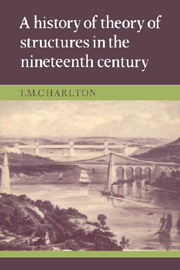Book contents
- Frontmatter
- Contents
- Preface
- 1 Introduction
- 2 Beam systems
- 3 Theory of the arch and suspension bridge
- 4 Elementary theory of frameworks: graphical statics
- 5 Theory of statically-indeterminate frameworks: the reciprocal theorem
- 6 Levy's theory of frameworks and bridge girders
- 7 Early developments of energy principles relating to theory of structures
- 8 The later development and use of energy principles
- 9 Applications of the least work principle: elastic theory of suspension bridges
- 10 Aspects of the further development of theory of structures
- 11 Secondary effects in structures
- Appendices
- Bibliography
- Name index
- Subject index
- Frontmatter
- Contents
- Preface
- 1 Introduction
- 2 Beam systems
- 3 Theory of the arch and suspension bridge
- 4 Elementary theory of frameworks: graphical statics
- 5 Theory of statically-indeterminate frameworks: the reciprocal theorem
- 6 Levy's theory of frameworks and bridge girders
- 7 Early developments of energy principles relating to theory of structures
- 8 The later development and use of energy principles
- 9 Applications of the least work principle: elastic theory of suspension bridges
- 10 Aspects of the further development of theory of structures
- 11 Secondary effects in structures
- Appendices
- Bibliography
- Name index
- Subject index
Summary
Much progress in theory of structures during the nineteenth century has been ascribed, notably by Clapeyron (1857) in France and Pole (Jeaffreson, 1864) in Britain, to the coming of the railway era. But the state of knowledge of the subject at the beginning of the century was ripe for rapid development due, for example, to Coulomb's remarkable research in applied mechanics. Early in the century Navier began to contribute to engineering science encouraged by his uncle, M. Gauthey, Inspector General of bridges and highways in France. Navier was born in 1785 and orphaned when he was fourteen years of age. He was adopted by Gauthey whose book on bridges he published (1809) and revised (1832), following his education at L'Ecole Polytechnique and then at L'Ecole des Ponts et Chaussées, from where he had become ingenieur ordinaire in 1808. He may be regarded as the founder of modern theory of elasticity and its application to structures and their elements. The year 1826 is memorable for the publication of Navier's celebrated Leçons as well as for the completion of Telford's remarkable wrought iron chain suspension bridge at Menai (it was also a year of sadness for Navier due to failure, prematurely, of the Pont des Invalides, a Paris suspension bridge which he had designed).
- Type
- Chapter
- Information
- Publisher: Cambridge University PressPrint publication year: 1982



